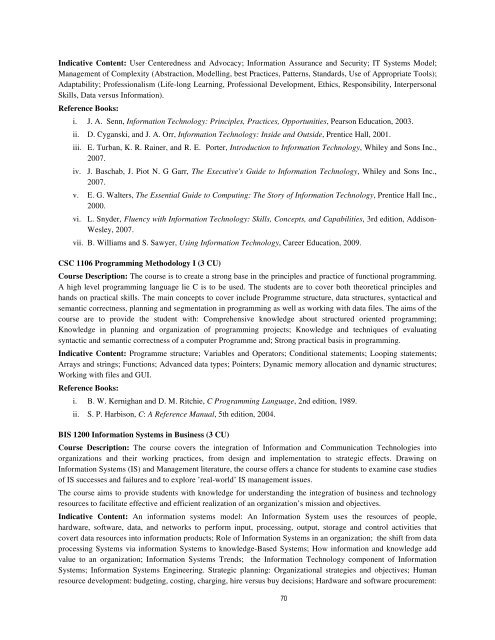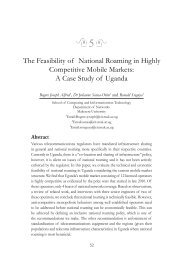Undergraduate Handbook - School of Computing and Informatics ...
Undergraduate Handbook - School of Computing and Informatics ...
Undergraduate Handbook - School of Computing and Informatics ...
You also want an ePaper? Increase the reach of your titles
YUMPU automatically turns print PDFs into web optimized ePapers that Google loves.
Indicative Content: User Centeredness <strong>and</strong> Advocacy; Information Assurance <strong>and</strong> Security; IT Systems Model;<br />
Management <strong>of</strong> Complexity (Abstraction, Modelling, best Practices, Patterns, St<strong>and</strong>ards, Use <strong>of</strong> Appropriate Tools);<br />
Adaptability; Pr<strong>of</strong>essionalism (Life-long Learning, Pr<strong>of</strong>essional Development, Ethics, Responsibility, Interpersonal<br />
Skills, Data versus Information).<br />
Reference Books:<br />
i. J. A. Senn, Information Technology: Principles, Practices, Opportunities, Pearson Education, 2003.<br />
ii. D. Cyganski, <strong>and</strong> J. A. Orr, Information Technology: Inside <strong>and</strong> Outside, Prentice Hall, 2001.<br />
iii. E. Turban, K. R. Rainer, <strong>and</strong> R. E. Porter, Introduction to Information Technology, Whiley <strong>and</strong> Sons Inc.,<br />
2007.<br />
iv. J. Baschab, J. Piot N. G Garr, The Executive's Guide to Information Technology, Whiley <strong>and</strong> Sons Inc.,<br />
2007.<br />
v. E. G. Walters, The Essential Guide to <strong>Computing</strong>: The Story <strong>of</strong> Information Technology, Prentice Hall Inc.,<br />
2000.<br />
vi. L. Snyder, Fluency with Information Technology: Skills, Concepts, <strong>and</strong> Capabilities, 3rd edition, Addison-<br />
Wesley, 2007.<br />
vii. B. Williams <strong>and</strong> S. Sawyer, Using Information Technology, Career Education, 2009.<br />
CSC 1106 Programming Methodology I (3 CU)<br />
Course Description: The course is to create a strong base in the principles <strong>and</strong> practice <strong>of</strong> functional programming.<br />
A high level programming language lie C is to be used. The students are to cover both theoretical principles <strong>and</strong><br />
h<strong>and</strong>s on practical skills. The main concepts to cover include Programme structure, data structures, syntactical <strong>and</strong><br />
semantic correctness, planning <strong>and</strong> segmentation in programming as well as working with data files. The aims <strong>of</strong> the<br />
course are to provide the student with: Comprehensive knowledge about structured oriented programming;<br />
Knowledge in planning <strong>and</strong> organization <strong>of</strong> programming projects; Knowledge <strong>and</strong> techniques <strong>of</strong> evaluating<br />
syntactic <strong>and</strong> semantic correctness <strong>of</strong> a computer Programme <strong>and</strong>; Strong practical basis in programming.<br />
Indicative Content: Programme structure; Variables <strong>and</strong> Operators; Conditional statements; Looping statements;<br />
Arrays <strong>and</strong> strings; Functions; Advanced data types; Pointers; Dynamic memory allocation <strong>and</strong> dynamic structures;<br />
Working with files <strong>and</strong> GUI.<br />
Reference Books:<br />
i. B. W. Kernighan <strong>and</strong> D. M. Ritchie, C Programming Language, 2nd edition, 1989.<br />
ii. S. P. Harbison, C: A Reference Manual, 5th edition, 2004.<br />
BIS 1200 Information Systems in Business (3 CU)<br />
Course Description: The course covers the integration <strong>of</strong> Information <strong>and</strong> Communication Technologies into<br />
organizations <strong>and</strong> their working practices, from design <strong>and</strong> implementation to strategic effects. Drawing on<br />
Information Systems (IS) <strong>and</strong> Management literature, the course <strong>of</strong>fers a chance for students to examine case studies<br />
<strong>of</strong> IS successes <strong>and</strong> failures <strong>and</strong> to explore ’real-world’ IS management issues.<br />
The course aims to provide students with knowledge for underst<strong>and</strong>ing the integration <strong>of</strong> business <strong>and</strong> technology<br />
resources to facilitate effective <strong>and</strong> efficient realization <strong>of</strong> an organization’s mission <strong>and</strong> objectives.<br />
Indicative Content: An information systems model: An Information System uses the resources <strong>of</strong> people,<br />
hardware, s<strong>of</strong>tware, data, <strong>and</strong> networks to perform input, processing, output, storage <strong>and</strong> control activities that<br />
covert data resources into information products; Role <strong>of</strong> Information Systems in an organization; the shift from data<br />
processing Systems via information Systems to knowledge-Based Systems; How information <strong>and</strong> knowledge add<br />
value to an organization; Information Systems Trends; the Information Technology component <strong>of</strong> Information<br />
Systems; Information Systems Engineering. Strategic planning: Organizational strategies <strong>and</strong> objectives; Human<br />
resource development: budgeting, costing, charging, hire versus buy decisions; Hardware <strong>and</strong> s<strong>of</strong>tware procurement:<br />
70

















